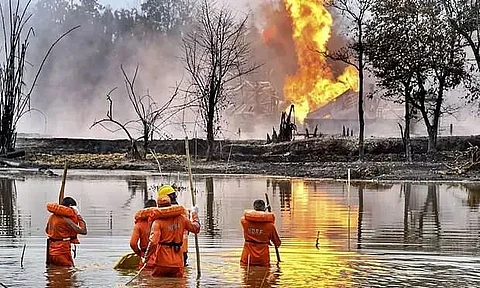
- Home
- Live Blog
- Breaking News
- Top Headlines
- Cities
- NE News
- Sentinel Media
- Sports
- Education
- Jobs

GUWAHATI: The gas well explosion in the natural gas well of Oil India Limited (OIL) at Baghjan in Assam's Tinsukia district made a devastating impact on the environment and biodiversity in and around the Dibru-Saikhowa landscape.
Who can forget the explosion which lasted for more than five months, from May 27 to November 15, 2020, damaging as many as 1,632 hectares of wetland, 523 ha of grassland, 172 ha of the area covering rivers and streams, and 213 ha of forest were damaged to varying degrees.
Notably, Mahendra Kumar Yadava, who was appointed by the Assam Government to investigate the impact of the blowout on the ecosystems around Baghjan in a report suggested that 55 percent of the biodiversity in the area has been lost.
These facts have come to light in the "Report on Damages to Environment, Biodiversity, Wildlife, Forest & Ecology on account of Blowout and Explosion at OIL Well number BGN-5, Baghjan, Tinsukia", submitted recently by the one-man inquiry committee headed by Mahendra Kumar Yadava, Additional Principal Chief Conservator of Forest and Chief Wildlife Warden, Assam.
The report also highlighted that the Maguri Motapung Beel, a wetland, was the most impacted of all the ecosystems. Almost 70 percent of the earthworms in the Maguri grasslands and condensate affected areas are estimated to be dead.
The report adds: "Post-blowout, the Gangetic river dolphin population has taken a hit. From an estimated population of 28-34 dolphins earlier, the current estimates point to not more than four dolphins. The underwater sound pollution is possibly impacting the dolphins adversely. The death of a dolphin is confirmed to have been caused by organic chemicals. The hoolock gibbons at Barekuri were adversely impacted by the oil spill. They refused to eat for at least two days. One mother gave birth to a stillborn baby, and she also died after a gap of 25 days. Most large mammals have moved out of the area, and a few that got trapped could have ingested organic chemicals while grazing and drinking water."
On the other hand, a study by Assam Forest Department suggested that the region has pegged losses to the tune of more than Rs 25,000 crores to the environment and biodiversity. Further, the estimated carbon earnings were valued at Rs.18,234 crore (during restoration) and this resulted in a net liability of Rs.6,800 crore over a period of 10 years.
Also Watch: